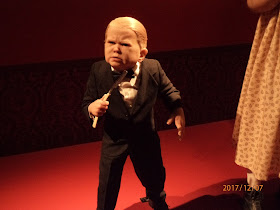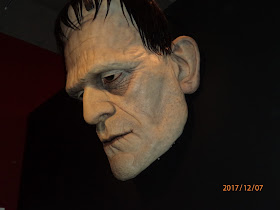While I was in Toronto to see the
Bat Out of Hell musical, I was able to attend the exhibit of
Guillermo del Toro's horror/supernatural/Victoriana collectibles at the Art
Gallery of Ontario museum (closed today, unfortunately). I will readily confess
that I am woefully deficient on del Toro's films, something I want to correct
now that I've seen the gent's “soul,” as mirrored in his insane collection of
“monster kid” dream artifacts.
I was utterly overwhelmed by the collection and did take photos – something I never, ever do in a museum, nor would I want to. At this exhibit, though, photography was encouraged and it seemed part of del Toro's sharing of his collection – that others could photograph and even pose with (at a reasonable distance, natch) the memorabilia and lifesize figures.
If you need background on the exhibit you can find it any number of places online. Suffice it to say that, since del Toro's film work has taken off and he has been hailed as one of the best horror/thriller directors working today (including a Best Director Golden Globe he won for The Shape of Water shortly after this blog entry was posted), he has invested his money in things that remind of the stuff that has comforted him over the years.
I was utterly overwhelmed by the collection and did take photos – something I never, ever do in a museum, nor would I want to. At this exhibit, though, photography was encouraged and it seemed part of del Toro's sharing of his collection – that others could photograph and even pose with (at a reasonable distance, natch) the memorabilia and lifesize figures.
If you need background on the exhibit you can find it any number of places online. Suffice it to say that, since del Toro's film work has taken off and he has been hailed as one of the best horror/thriller directors working today (including a Best Director Golden Globe he won for The Shape of Water shortly after this blog entry was posted), he has invested his money in things that remind of the stuff that has comforted him over the years.
There has always been a kind of “club” feeling among those who love horror, sci-fi, and monster movies – from the earliest American fans who organized (whose ranks included the “unholy three”: Ray Harryhausen, Ray Bradbury, and Forrest J. Ackerman) to goth kids and well beyond. There will be no end to this phenomenon (as witnessed by the “creepypasta” fans online and the endless flow of near anonymous horror flicks that still make it into theaters in this era of streaming and downloads).
At the outset I will mention that there were two points in the exhibit in which I was emotionally touched by del Toro's fan boy-ishness. The first was right at the beginning, in which a video greeting by del Toro acknowledged the person who inspired his collecting hobby. That person was, of course, Funhouse interview subject Forry Ackerman, perhaps the greatest “monster kid” of all (and certainly one of the first to be proudly recognized as such). del Toro notes in the opening video that hearing about Forry's “Ackermansion” made him want to have the same kind of crazy collection. And while he lacks Forry's connection to the great men of yesteryear (Karloff, Lugosi, Price, Lang, and Willis O'Brien), he has compensated beautifully by having incredibly realistic-looking mannequins made of his favorite artists and “monsters.”
When it is not being lent to a museum for an exhibit, the collection resides in del Toro's “Bleak House” in L.A. (He's also a big Dickens fan.) Perhaps the most important thing about the exhibit was that he was emphasizing not just film but reading matter throughout – kids were brought there by their parents (who were most likely into this stuff growing up) and they saw that books (and, naturally, comics) are a seminal “path” that leads to a thorough exploration of the enjoyably eerie part of our pop culture.
The mannequins in the exhibit are incredibly life-like. They resemble the beautifully rendered pieces at Madame Tussaud's (although I believe no wax was involved in the creation of these figures/statues/models/mannequins – they are referred to by all these names online). The one that first reinforced the literary connection to weirdness is the figure of Poe that was seated and seemed ready to converse with visitors to the museum.
Seeing this wildly life-like version of an extremely long-dead author made one realize how deeply del Toro is devoted to his passions – a lot of these figures would completely creep out even the most dedicated horror buff (the ruminations about waking up and stumbling toward the bathroom and walking into a creepy-looking statue began among the attendees when inside the “rain room” that housed the Poe figure).
Poe is the pathway, Lovecraft is the uncut drug. The figure of Lovecraft is uncannily real-looking. He was situated in a room that had the covers of every book found in Lovecraft's library pasted on the wall and several busts and smaller statues of Lovecraft's trawlers “from beyond” displayed across from the figure himself (to complete the creepiness, the AGO hired a pianist to play suitably “Phantom”-esque music in the room).
But much of the exhibit was naturally tied up with movies, del Toro's own and the ones he clearly lived and thrived upon throughout his youth. The range was from the silent era to the much-loved cult pics of the Seventies (both the films that were more successful when they went to midnight shows, like The Phantom of the Paradise, and those that made money when they were initially released, like Alien).
The devotion to childhood and adolescent heroes was apparent throughout the exhibit. Like many of us, del Toro grew up worshipping the inimitable Boris Karloff, and his rogues' gallery of immortal horror characters. del Toro has noted in interviews that he found a sense of belonging when he discovered Uncle Forry's Famous Monsters of Filmland magazine, and there was no better person to salute the glories of Karloff than the late pun-master, Mr. Ackerman. Karloff will always remain to many of us the “king of monsters.”
There are many disturbing life-size (and bigger!) creatures in the exhibit, many of which are scary to behold and must've taken some care in mounting, since they are (again) so goddamned big. But what was undoubtedly the scariest set-up to me were three “innocent”-looking figures lurking in the corner of one room of memorabilia. These three cast members of Freaks (1932) retain their power to both intrigue and scare the crap out of the ordinary schlub encountering them.
When I went to the exhibit, a bunch of teenage students were being taken through it by a very nice, open-minded, clearly very liberal teacher, who was explaining Todd Browning's film to the assembled young minds. Her argument was that we don't use the word “freaks” any more, but do call these people “outsiders” while we try not to discriminate against them in society. She preached the joys of diversity and inclusivity, and spoke (rightly) of the film's true message of brotherhood.
While listening to this heartening speech by the teacher, I was watching del Toro's own videotaped intro to the figures, which said, simply enough, that he loved Freaks because the “good-looking people are evil” and the scary-looking people are good and support each other in a very tight-knit community. He hit the nail on the head in 2-3 minutes, while the teacher continued to preach as the teens were simultaneously attracted and repulsed by the three figures on the platform in front of them.
While the teacher is indeed right – we should not in any way discriminate against people who look different than us – she had seemingly forgotten that Browning was a showman (he worked with fr… er, “outsiders” like the ones in the film before he started directing). He made Freaks after his Dracula had been a gigantic hit and he could do whatever he wanted. He *did* want to preach a gospel of diversity, inclusivity, and brotherhood among outcasts – but he also wanted to scare the shit out of the viewer.
The “normal” person's response to the people in the film is certainly to be both attracted and repulsed by the “different” people in the film – they mean no harm, but their appearance initially scares us. We come to love them in the film and enjoy their sense of community, but they also scare the hell out of us when they decide to “punish” the woman who has wronged their friend.
I had a friend once tell me that the “freaks” didn't scare him because he could run away from them, and I had to remind hm that the film's alternate message was that, when you wrong these people, they will get you one way or another. Even the one gent who lacked both arms and legs would most certainly slice your throat while you were asleep as he chinned himself along the ground to get to you. (Yes, you can run now, but you can't run forever…).
Enough for the thoughts that flittered into one's mind while seeing del Toro's incredible collection. The room that produced very emotional feelings for me was “the comic room,” in which they had hung up del Toro's original comic art (with everyone from Eisner to Moebius on display) with many of the comics he owned – and Famous Monsters issues at eye-level.
The room overwhelmed me because it made me think of going to comic-cons in the early Seventies with my father and the way in which he introduced me to all of that material – from FM to Eisner to EC Comics and well beyond – and how the later items (like Neil Gaiman's Sandman) were things I was able to share with him when the time came that I was still going to comics stores and he wasn't. You may think a bunch of funny-books might not hold any emotional undercurrent but they do, believe me, they do.
The piece de resistance was in the final room: a celebration of the Frankenstein monster, most specifically the monster as played by Karloff in the first three films of the series (1931, 1935, 1939 – committed it to memory as a warped little kid).
With every book cover that featured the monster's likeness on the wall, and life-size figures in the center and on the sides, and even more Franken-art in other parts of the room, it was an overwhelming celebration of the ultimate “outsider” figure in monster-movie lore.
del Toro's collectibles are supposedly headed back to his suburban home in L.A. (the place he has dubbed “Bleak House”), but there's still a chance the exhibit may be reconstituted in another city in the U.S. or overseas. I'm glad I took these pictures, but there is something overwhelming about seeing all that stuff in one place. And, of course, coming face-to-face with one's childhood/adolescent dream and nightmare figures in a museum setting.
Thanks to "monster kid" emeritus Kayleigh for recommending this exhibit and fellow Famous Monsters fan M. Faust for sharing it with me.




















You should watch "Crimson Peak" to me it was bit like a crossover between Rebecca and The Shining.
ReplyDelete